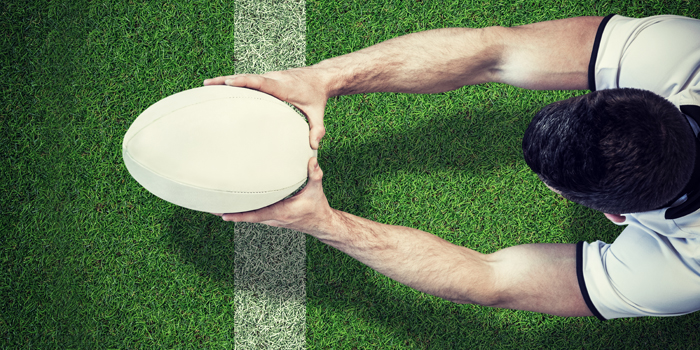
Caveat: This article is not a research-based sports science article; it is to be used with this caveat in mind. All italicized points are direct quotes from the respondees.
In January 2017, Marc Keys (castironstrength.com) and I embarked upon a labor of love to develop a questionnaire to investigate what the various groups of people who make up the rugby industry think are the key elements of the physical preparation of the rugby player. My thanks to Marc for all his work in developing the initial survey and updating the records as time went by.
Click here for the questionnaire.
It has taken a while to compile and apologies to all those who replied to the questionnaire, so any inaccuracies in the reporting are entirely my own. We used a 1 to 5 scale, with 1 being least important and 5 being most important; all averages are rounded to one decimal place.
Of course, with this type of survey/questionnaire, there are likely to be some inaccuracies: Was there collusion between players doing it at the same time? Have players and strength and conditioning coaches responded as accurately as possible? Did players have preferential biases behind the answers, such as “I like training for this, but not for this”?
The survey was sent internationally, but one flaw in the reporting process was that the competition that each respondee was currently involved in was not requested. Many aspects are open for individual interpretation, but I sincerely believe that it is a solid starting point to open discussions with groups to attempt to get the best possible training plan in place to optimize rugby performance.
World Rugby lists the key physical fitness components required to play the game of rugby as:
- Strength and power
- Speed and agility
- Endurance — general endurance and multi-sprint/activity
In my words: fitter, faster, and stronger, but to break this down further, we needed to categorize elements within each component of fitness. For this particular survey, the following areas were investigated:
- Strength: maximal strength, power, muscular endurance
- Metabolic: aerobic ability to recover, repeated efforts ability to complete high-intensity efforts back to back, contact fitness
- Speed: first step quickness (0-5m), acceleration (5-20m), top-end (30+m)
- Agility: acceleration/deceleration, lateral (slide/shadowing in D), footwork/sidestep
John Mitchell, a strength and conditioning coach for the Australia 7s and at the Australian Institute of Sport, has written a very good article on the physical characteristics of the rugby player. This article is an excellent starting point for those wishing to train rugby players. We wanted to delve into the training of the rugby player from the perspective of both support staff, position coaches, strength and conditioning staff, and the players themselves.
Coaches
Unfortunately, only eight coaches responded to the questionnaire, but those who did gave some very interesting insights into what they feel is required of the players to whom they teach the game. With such low numbers, the statistical power is not great but still allows us to see what they would expect of the players.
RECENT: The Grand Unified Theory of Everything
Strength
- Maximal strength: 3.6
- Power: 4.3
- Muscular endurance: 4.1
What style of strength training do you find most beneficial?
- Hypertrophy and plyometric type training.
- Olympic lifting + strongman-type activities
- Not traditional — this will be offensive to most strength and conditioning coaches, but personally, I’m not a fan of your traditional squat, bench, chin focus. I get that a strength base is required. However, the more training is tailored to the individual once that base is achieved at the expense of traditional strength and conditioning is my preference. Put it this way — I've utilized time that a strength and conditioning coach would normally allocate to squat with more skills power-based activities and players have tested better in squat regardless of not having done for a period of 8 weeks.
- Power and explosive training
- Power endurance
- Functional position-specific strength and power activities underpinned by core strength program.
- I like small group strength programs which encourage accountability, teamwork, and communication.
- Olympic/strongman
- Key lifts: Squat, push, pull and hinge. Nothing fancy.
Metabolic
- Aerobic: 4.9
- Repeated Efforts: 4.6
- Contact Fitness 4.4
READ MORE: The Most Important Training Article You Will Read This Year
What kind of fitness training do you find most beneficial?
- Full-body exertion. (i.e., changes in body elevations and changes in speed repeatability)
- Conditioning games
- Again, the more tactical-based conditioning that can be achieved, the better. Players obviously need to be working at or above the extremes of the game in this type of conditioning. But the more tactical requirements can be integrated into conditioning, the better. Again, just my opinion.
- Repeated effort
- Intervals
- High proportion of rugby-specific fitness training supplemented with core aerobic work to develop mental toughness. Lots of ball use and always competitive. Program must include getting off the ground, contact/collision and multidirectional work.
- Circuits/CrossFit
- Game-based running, ruck/combat conditioning and short blocks of MAS
WATCH: Rugby Top-5 Strength and Conditioning Equipment Picks
Speed
- First Step Quickness: 3.9
- Acceleration: 4.3
- Top End Speed: 3.1
Agility
- Acceleration/Deceleration: 4.3
- Lateral Movement: 3.9
- Footwork/Sidestep: 4.0
What style of speed/agility training do you find most beneficial?
- Repeated sprints with lateral movements. Footwork, I think, is key. Being able to move efficiently. Fluid dynamic movements is king.
- Small-sided conditioning games
- Anything that is underpinned by the philosophies of Frans Bosch — I think is most transferable.
- Acceleration — first steps and 5-20m Agility — Lateral and footwork
- Change directions
- Rugby-specific game/competitive/replicating movement patterns/always involving a ball/ fend when attacking, etc.
- SAQ
- Reactive to a physical cue (i.e., another player)
The responses of the coaches show very up-to-date knowledge of the strength and conditioning areas, and this is extremely valuable for discussions between the coach and physical preparation staff so that they are on the same page and understand where the other partner is coming from.
Medical Staff
Only two medical staff replied to the questionnaire, so I have excluded them from this analysis. However, if you are interested in finding out the responses from them, I have included a link to the complete table at the end of this article.
As the survey was sent out in the middle of a European season, I can understand that medical staff were extremely busy, it would be great to get feedback from this group so that strength and conditioning is aware of what medical staffs are thinking about training and how we can integrate aspects of each into the overall program.
Playing Staff
Only the players who completed all aspects of the questionnaire have been included in this analysis. The complete spreadsheet of all responses is included as a link at the end of this article. Any duplications were also excluded. A total of 43 responses were analyzed for this article. All positions except the right-winger (Number 14) have at least one representative in this analysis.
Strength
Forwards (24 in total)
Backs (19 in total)
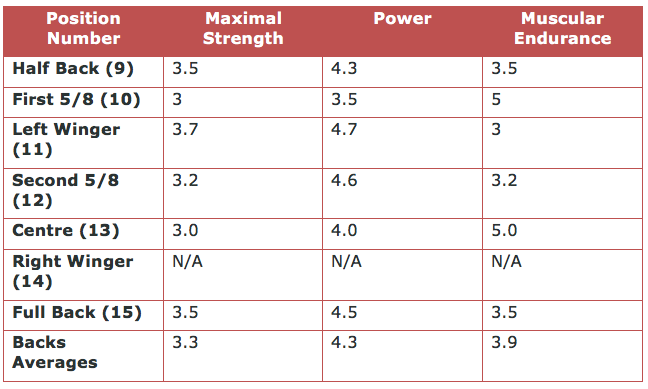
What style of strength training do you find most beneficial?
- Traditional
- 5 x 5
- 3x heavy then 2x drop set
- Power
- Low reps, high sets
- Box squat
- Speed – Power
- Olympic, strongman, and compound movements
- Power
- A mix of heavy pressing, squats, and compound lifts, alongside more dynamic movements, such as cleans and jerks. Snatches, in my opinion, are largely a waste of time for most rugby players, as the amount of time required to train technique doesn't justify the weight being shifted, and flexibility in older players makes it an injury risk.
- Combination of pure strength and power-endurance exercises
- Clusters and wave-loading
- Max strength
- Strength-power
- Power-based
- Squats/Cleans
- Free weights (compound lifts, 60-90% max effort)
- Metabolic Fitness Circuits
- Power, moving weights along with bodyweight as quickly as possible
- Explosive
- Power training
- Max effort method
- Bodybuilding style
- Speed-strength
- Power
- Heavy weight-based
- Low reps at 80-90%
- Bodybuilding for strength, crosstraining methods, (CrossFit) for cardio/recovering
- Lafay (Bodyweight training method from France)
- Power
- Light/medium Olympic lifts – higher reps
- Heavy weights
- Maximal strength training
- Power
- Bentover row
- Percentage-based wave loading
- Olympic lift
Metabolic
Forwards (24 in total)
What kind of fitness training do you find most beneficial?
- Watt bike/repeated sprint run
- Circuit training
- Back-to-back sprints
- Running
- Con games with some fitness drills
- Speed endurance
- Rugby-specific
- Anaerobic games, having to switch from attack to defence without rest
- Anaerobic
- Match situation fitness
- Interval training
- Shuttle training interval
- High intensity, short duration
- Beastly workouts/con games
- Endurance
- In rugby (con games)
- CrossFit
- HIIT
- Small-sided games
- HIIT training
- Plyometrics
- Longer distance running
- Aerobic
- Anaerobic
- Fartlek
Speed
Forwards (24 in total)
Backs (19 in total)
Agility
Forwards (24 in total)
Backs (19 in total)
What style of speed/agility training do you find most beneficial?
- Sprints
- Gate speed
- Hurdle and resistance
- Footwork
- Plyos
- 10m or plyos
- Gate, sled pulls, box jumps, reaction jumps
- Bounds and directional bounds
- Speed of the mark
- Fast ground contact time was a big thing for me, so lots of box jumps, hurdles, and speed ladders. I found it helped integrating these exercises into a power session, as the fast feet concept is transferrable throughout Olympic movements and plyo exercises.
- Nothing can replace the real thing (i.e., running drills v. live opposition)
- Weighted and banded sprints
- Plyometrics
- Repeated sprints
- Acceleration
- Speed sessions using sleds
- Touch games/1v1
- Hill sprints
- Acceleration and deceleration work
- Technique. Get the movements right then repeat. I don't think we do enough of this.
- Hurdles, sleds, and running fast
- 0-20m speed with change of direction
- Speed gates
- Ladder work, sleds, 10, 20 and 30m sprints, or reaction-based speed.
- Repeat effort speed
- Flyes, sprint, and techniques
- Acceleration depart training
- Straight-line acceleration
- Ladders
- Footwork/ladders/gates
- High school intensity
- Movement into efforts
- Couldn't say, never focused on that
- Races, 1v1s, competition
- Distance/Indian tunning
- Short sprints
- Speed gates or competitive drills
- Lateral
- 10m speed
- Sled work, plyometrics
- Plyometrics
RELATED: How Stuff Works: The Knee Wrap
The playing group is an extremely valuable source of information for strength and conditioning staff, especially the veterans on the team, who have seen a number of various styles over their years in the game. It is important to be careful when prescribing based on just this information in isolation as most players, as is human nature, have their individual favorite styles, and also often the results of the survey would be specifically favorable to what the current playing group was doing at that particular point in time.
Strength and Conditioning Coaches
Forty-four strength and conditioning coaches completed the survey, including one person who was listed as an integral performance coach, which begs the question of what do we believe we should be called, but that is for another article. Of these strength and conditioning coaches, 20 had actually played the game, but unfortunately, we do not have the level to which they played.
Strength
- Maximal Strength: 3.9
- Power: 4.6
- Muscular Endurance: 3.0
What style of strength training do you find most beneficial?
- Basic strength training done in a manner that has players feeling fresh for games but allows them to make progress when they have an opportunity to do more.
- Max strength, strength-speed
- Combination of max strength, explosive strength, and power
- Mixed methods of strength prescription. Full FVC max through to low load speed-strength. Dependent upon athlete strength and weakness depends on percentage of each.
- Strength-power
- Focus on basics that don't impact rugby content.
- Explosive training
- Classic powerlifts, Olympic variations, and jumps
- Conjugate method, linear periodization in pre-season, waving periodization in season, working on all qualities of strength curve (vertical integration), structural balance to prevent injuries, upper body main lifts, gymnastics, lower body main lifts, unilateral, plyos, Olympic lifts, core anti-flexion, and anti-rotation
- Power training into maximal strength work
- Traditional
- Power-maximal strength
- Simple: Use Prilepin’s Chart and ensure players hit the 70-85% bracket in-season
- Compound exercises, primary, basic exercises with superset of assistance exercises. Sets and reps progress over 4-6 week period
- Well-rounded traditional strength training program focusing on rate of force development.
- Contrasting strength with power or speed drills
- Cluster
- Modern functional training
- Contrast
- Training that's specific to the dev stage of the athlete. Ultimately, we need a number of effective styles and cycle these over time. Generally, well-structured training, motivated athletes, clear direction, great intensity, and consistency are the key elements for me.
- Combination of fundamental and specific elements. And based on individual requirements.
- Contrast training.
- Modified Westside method
- Strength training that is max strength-based, accompanied by an individual focus on the athletes’ needs, whether it be power, metabolic emphasis, size, etc.
- Compound exercises not performed to failure
- Weightlifting
- Power development
- Strength-power
- Heavy simple gym-based exercises paired with loaded position-specific movements
- Strength-power
- Conjugate periodisation, reactive (rfd), and power and strength
- Strength-speed work
- Biggest hitter would be max strength but love to work along the force-velocity curve. Athlete-dependent
- Combinations that target CNS and improving properties of tissue
- Autoregulation
- Simple compound-complex movements. Technique focus progressed to increased intensity (%RM) and using time under tension (TuT). Movement speed (Gymaware).
- Strength-speed barbell training
- Plateau sets and autoregulation
- I believe a linear approach to periodising strength development makes sense for the younger players ages 15-18; however, an undulating approach will likely support further development as the player's training age increases. An undulating program allows direct support for the diverse demands seen in rugby, which creates a balanced approach to the in-season maintenance of multiple strength qualities. I think there are many methods that can be used within this approach; however, I think that maximal strength and power are supported by the use of accommodation training, VBT protocols, cluster work, and appropriately volume load variation within primary lifts. Further, I believe that power needs to be bolstered through movement skill development (linear and multidirectional speed), with plyometrics, while also important, not being used as a proxy for these skills.
- Hybrid style
LISTEN: Table Talk Podcast #18 with Vincent Dizenzo, Matt Rhodes, and Jim Wendler
Metabolic
- Aerobic: 3.9
- Repeated Effort: 4.4
- Contact Fitness: 4.1
What kind of fitness training do you find most beneficial?
- Contact work, down-ups, bag work, and a mixture of running/games.
- Metabolic conditioning
- Conditioning games interspersed with contact and repeated high-intensity conditioning
- Combination of games, RSA, combat, off feet. Again, player-dependent
- Metabolic aerobic (High-intensity aerobic-based touch games)
- Conditioning games
- Mix of contact/wrestling, shuttles, and games
- Repeated sprints and HICT step-ups (or anything like that)
- MAS long to short intervals then conditioning games, small-sided games, strongman
- Repeated speed involving hitting tackle bags and down-and-ups
- Interval
- 15/15 and RSA
- Small-sided games and wrestling
- Interval-style training
- Combination of aerobic and anaerobic work with and without the ball
- Repeat efforts 10 on-off for 3-5 blocks with distance to reach and contact conditioning. Conditioning games
- Metabolic circuit
- I have doubts
- Games and MAS runs
- Mixture of general conditioning focused on overloading the fitness quality, games-based conditioning to engage the players, and in rugby, drill conditioning for true specifics.
- Game-specific based on high-intensity aerobic work capacity.
- Short shuttles
- Combat- and/or collision-based RHIE
- Rugby specific training accompanied by an individual focus on the athletes’ needs — be that extra field top-ups, circuits, off-feet conditioning, etc.
- In-built into rugby session drills
- Fitness game
- Game style
- Recovery
- Position-specific drills and game-based scenarios
- Repeat effort (anaerobic) with active rest (aerobic)
- Anaerobic (repeated speed) (off the ground repeatability)
- Extensive tempos and alactic capacity work
- Repeated sprints
- Game-based conditioning, sprinting, wrestling
- HIIT
- Focus field-based running MAS and other aerobic power activities blended with cross-training options (e.g. underwater running/hypoxic, Watt bikes, etc.)
- Fartlek/small-sided games
- Maximal aerobic speed (MAS)
- Generally speaking, a MAS-type program can be used to bolster a base and safely scale chronic workload tolerance seems useful as players transition into the off-season. However, game-specific conditioning developed in the context of practice should be the primary format with which we develop the players conditioning. Thus, a balanced approach uses contextualised/de-contextualised aerobic and anaerobic (repeat sprint/COD) sessions to ramp up and/or top-up key qualities with a games-based approach to conditioning providing the required specificity in the context of competition. Note that the substance of these sessions should be associated with a proper analysis at a game and a positional level.
- Positional Game Simulation
Speed
- First Step Quickness (0-5m): 4.3
- Acceleration (5-20m): 4.3
- Top End (30+m): 3.2
Agility
- Acceleration/Deceleration: 4.0
- Lateral: 3.8
- Footwork/Sidestep: 3.7
What style of speed/agility training do you find most beneficial?
- Straight-line sprinting and some conditioning games.
- Linear, COD, acceleration, deceleration
- Max acceleration with high intense skills
- Acceleration predominantly. Personal opinion: this stimulus needs to be hit weekly. Skill as well as physical quality. Applicable to all rugby athletes
- Agility applied in via rugby conditioned skills/scenarios (e.g, 1v1, 3v2 combos) combined with speed acceleration
- Resisted sprints, regularly sprinting in general
- Reactive agility and 10m accels
- Low-volume sprint work, jumps, throws, etc.
- Speed: contrasts, acceleration drills, hills; Agility: 1v1, 2v2, 3v3
- Conditioning games
- Open rugby-based
- Short-run footwork
- Simple acceleration drills and resisted sled work
- 10-20m sprints with jump training in gym for speed. Agility is worked into warm-ups or sessions on field with decision-making
- Acceleration work with sleds, heavy and light. Reactive speed with ball included.
- Acceleration: 5, 10, 15, 20m with skill and COD executed at speed
- Sprint repeated
- Interval training and reduced games
- Sleds, resisted runs, and fitness games
- Blend of general to expose the underlying quality, acceleration, lateral movement, steps etc., then specific drills to add the decision-making, deception components.
- Dynamic ROM and horizontal movements with emphasis in hip joint. Proper stabilization of posture and lower extremities in any direction.
- Typical SAQ stuff minus the ladders.
- Speed- and agility-based work primarily integrated into rugby field sessions supported by specific speed and agility work as part of pre-gym or pre-field session
- Basic sprinting
- Plyometrics
- Plyometric Strength
- Speed side-step
- Drills progressing to live situations including decision-making, first step quickness
- Pure speed 0-5/10 with 1 minute of recovery 0-20/30 with 2-3 minutes of recovery
- Resisted and unresisted sprints over 10-30m
- Resisted acceleration and small-sided games/1v1 for agility
- Speed or agility work that are worked on independently only to master the skill, afterwards, they have to be trained within a game setting so that timing and selection of techniques is actually effective when working with teammates and against a genuine defence.
- Varying shuttles
- Technique progressed into use of a variety of "toys" (bands, reactive lights, belts, games, etc.)
- Small-sided games (specific)
- Technique work and resisted running
- Speed should be developed in the off-season for all players and maintained, as best we can, throughout the in-season. However, players that are non-23 and/or have been identified as players requiring speed top-ups should also have a consistent dose of speed strategically positioned throughout the season. Regarding development, I believe that rugby provides the basis for multi-directional speed and decision-making. However, it does not develop movement quality explicitly. Thus, change of direction and agility work should primarily focus on movement quality, rate of force development, and relevant decision-making scenarios. This is best integrated into warm-ups, 2-3 times per week in the off-season and 1-2 times per week during the in-season, with exposures ranging from 10-30 minutes. Conversely, linear speed development needs a more direct approach as the exposures in rugby are highly variable, especially as it relates to maximal velocity running. Thus, in the off-season, two sessions per week lasting 45 minutes each will suffice to develop speed; however, three sessions per week is optimal. Within the in-season, integrating speed into the warm-up in the same manner as multi-directional speed is likely the best solution. However, top-up weeks and top-up sessions should be identified throughout the year, as maximal velocity detrains quite quickly, especially those with a lower training age. Strategies for developing acceleration include wall drills, harness drills, sled drills, and a primary dose of free sprints. Strategies for developing maximal velocity include light sled work (<10% bodyweight) but primarily focus on free sprinting over 30-50 meters. Integrating the work of Shane Malone in the GAA suggests that in addition to managing acute-chronic workloads, we should also be examining a minimal threshold of maximal velocity exposures per week to protect against injury.
Conclusion
As you can see the variety of physical performance methods utilized by strength and conditioning coaches show a reliance on the tried and tested methods but with the individual variation of content that you would expect.
READ MORE: The Most Important Training Article You Will Read This Year
Franz Bosch has had a major impact on programming for rugby with some high-profile international players adopting his methods as well as many strength and conditioning coaches. There is by no means one dominant method to train individuals and teams, but getting the buy-in of the players, coaches and medical staff to the strength and conditioning vision is essential to the overall success of the program.
As I mentioned at the beginning of this article, this is but a small sample size, so any conclusions from the information need to be considered with this mind when integrating them into your own programs.
I would like to thank Marc Keys for all his work on this project because, without him, it would not have seen the light of day; and to all the players, coaches, medical staff, and strength and conditioning coaches who took the time to respond to the survey, a huge thank you for helping us see what we do in a variety of different ideas and thoughts to assist us in making the development of the players even better over time.
Strength and Metabolic

Speed and Agility

Whilst it is difficult to make significant comparison due to the small sample sizes of each group, a couple of aspects of this comparison surprises me. The emphasis that coaches and players put on muscular endurance is in stark contrast to that of the strength and conditioning coach. Also, the fact that the coaches rate aerobic fitness so highly in comparison to the other groups.
All other components of physical performance tend towards a fairly homogenous tendency, although I would have thought in my own experiences that backs would have rated top-end speed significantly higher than they did and that forwards would have rated the aspects of agility higher than they did. Whether this is my fault that the aspects were not explained well enough can certainly be a reason.
The other major consideration when reading and interpreting this information is the fact that the people responding to the survey would have been predominantly, if not exclusively, involved with professional rugby.
With that fact in mind, the junior player needs to work on basic strength in the major movements. Strength underpins all other bio-motor qualities, and even though the survey respondees averaged 3.7 across the entire group for maximal strength importance, this aspect needs to form the basis of your strength program for a number of years.
As a junior player, being stronger and aerobically fitter than your opposition will go a long way toward success and emphasizes skills, maximal strength, and fitness as your physical preparation key elements and add to this base as you move through the age groups.










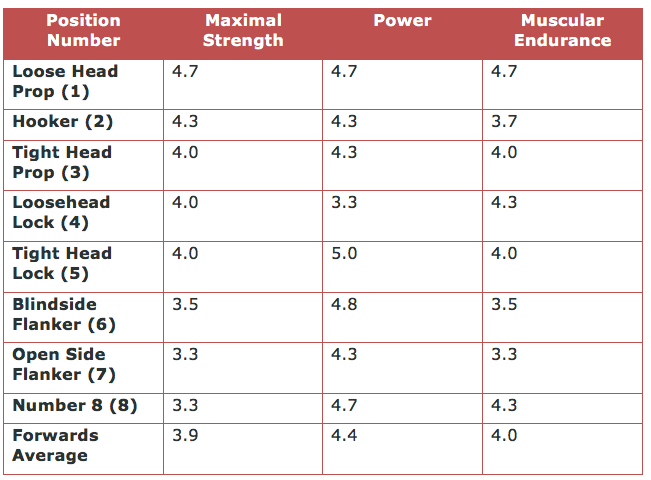
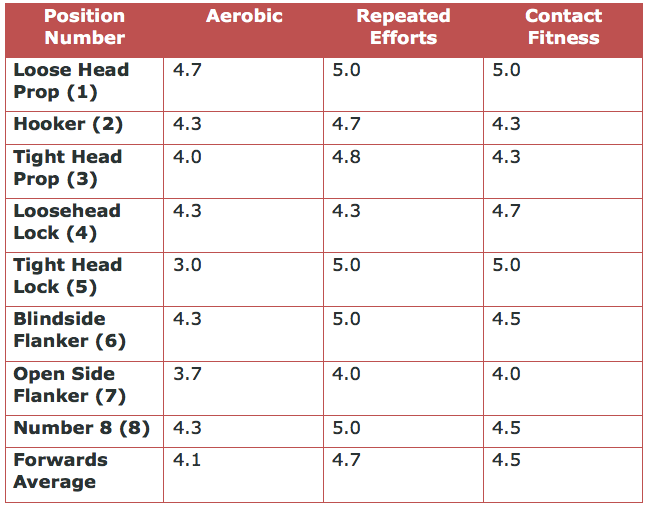
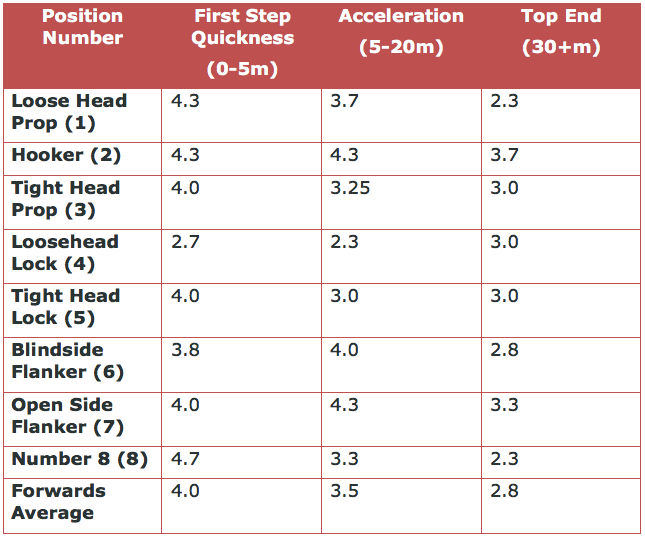
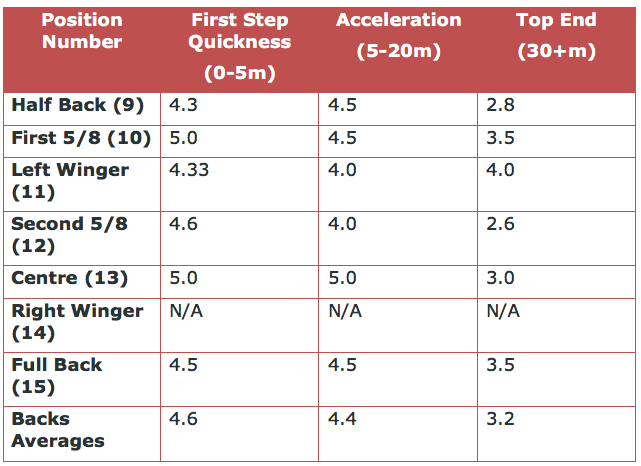
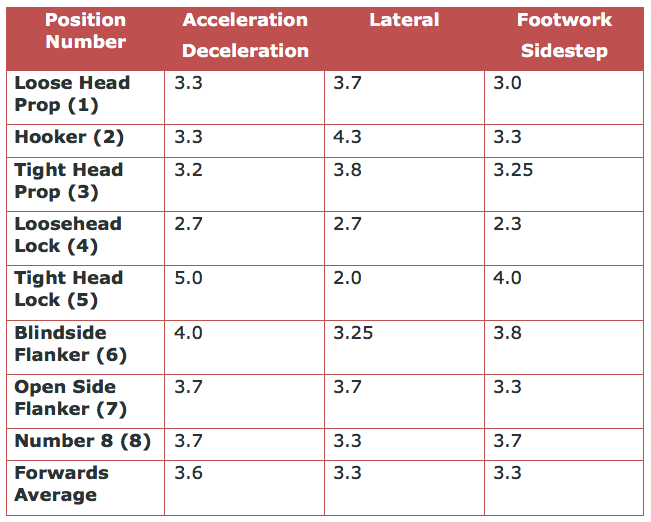
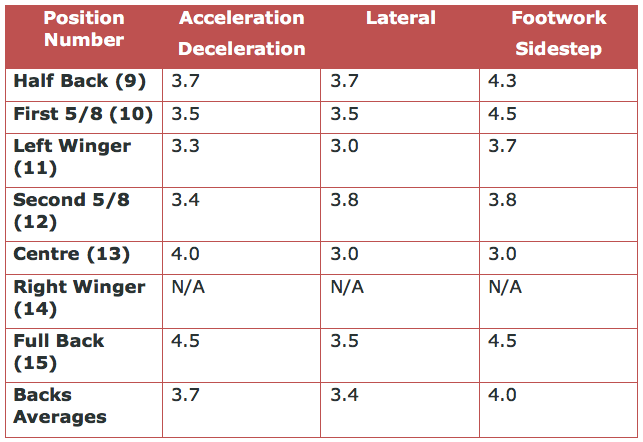

Love hearing others opinions and what they are implementing in the Rugby S&C world.
Cheers, Jono
I've been reading about some Physical Requirements of NFL players just to also compare their positions relative to Rugby Positions.
Have you ever thought about doing a Rugby Combine for your Players ? With your time at Crusaders did you test all the players throughout the Academy ?
I must say if you look t NFL players, 99% of those guys are absolutely educated regarding their training and requirements. The Combine tests is really like the ultimate Job interview and they prepare very good for it. Those guys know the Physical Demands of the game is the first stepping stone towards a big contract and they make sure they get the best Coaches, Best gym and educate themselves for the occasion.
Maybe it really is something Rugby as a whole should look into. Too give Players certainty to what Coaches expect at what level and will force them to be at the top of their game.
What is your thoughts ?
Greetings
Eddie